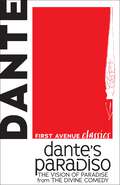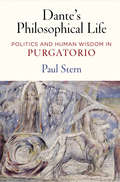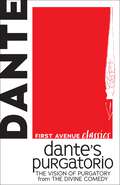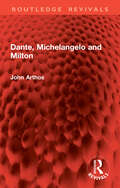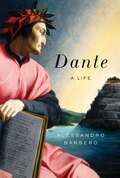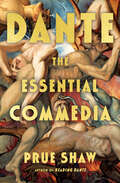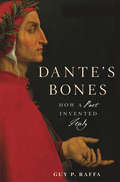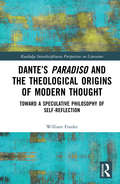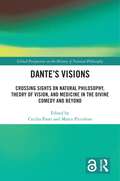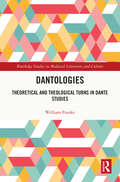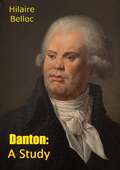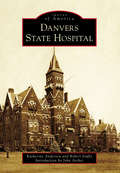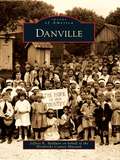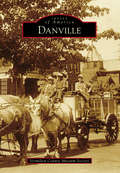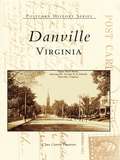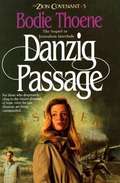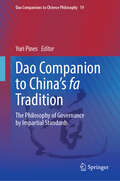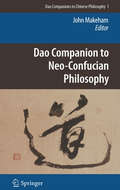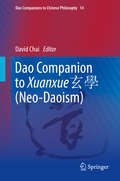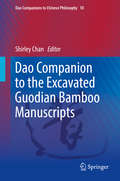- Table View
- List View
Dante's Paradiso: The Vision of Paradise from The Divine Comedy (First Avenue Classics ™)
by Dante AlighieriParadiso is the third and final part of Italian poet Dante Alighieri's epic poem Divine Comedy and describes Dante's journey through heaven. He is now led by Beatrice, who joined him at the end of Purgatorio. Beatrice takes Dante into the nine celestial spheres of Heaven. From the First Sphere, where they find those who were good but did not keep their vows, to the Ninth Sphere and the Empyrean, the home of the angels and God, Dante experiences the blessings given to those who live a life faithful to God. Dante wrote his narrative poem between 1308 and 1321. This version is taken from a 1901 English edition, featuring British author Rev. H. F. Cary's blank verse translation and woodcut illustrations by French artist Gustave Doré.
Dante's Philosophical Life: Politics and Human Wisdom in "Purgatorio"
by Paul SternWhen political theorists teach the history of political philosophy, they typically skip from the ancient Greeks and Cicero to Augustine in the fifth century and Thomas Aquinas in the thirteenth, and then on to the origins of modernity with Machiavelli and beyond. Paul Stern aims to change this settled narrative and makes a powerful case for treating Dante Alighieri, arguably the greatest poet of medieval Christendom, as a political philosopher of the first rank.In Dante's Philosophical Life, Stern argues that Purgatorio's depiction of the ascent to Earthly Paradise, that is, the summit of Mount Purgatory, was intended to give instruction on how to live the philosophic life, understood in its classical form as "love of wisdom." As an object of love, however, wisdom must be sought by the human soul, rather than possessed. But before the search can be undertaken, the soul needs to consider from where it begins: its nature and its good. In Stern's interpretation of Purgatorio, Dante's intense concern for political life follows from this need, for it is law that supplies the notions of good that shape the soul's understanding and it is law, especially its limits, that provides the most evident display of the soul's enduring hopes.According to Stern, Dante places inquiry regarding human nature and its good at the heart of philosophic investigation, thereby rehabilitating the highest form of reasoned judgment or prudence. Philosophy thus understood is neither a body of doctrines easily situated in a Christian framework nor a set of intellectual tools best used for predetermined theological ends, but a way of life. Stern's claim that Dante was arguing for prudence against dogmatisms of every kind addresses a question of contemporary concern: whether reason can guide a life.
Dante's Purgatorio: The Vision of Purgatory from The Divine Comedy (First Avenue Classics ™)
by Dante AlighieriPurgatorio is the second part of Italian poet Dante Alighieri's epic poem Divine Comedy and describes Dante's climb up the Mount of Purgatory. As in the Inferno, the Roman poet Virgil is guiding Dante on a journey; this time they visit the seven terraces of Purgatory, where sinners are cleansing themselves in preparation for entering Paradise. Each of the terraces represents one of the seven deadly sins, ranging from pride to lust. Through this allegory, Dante conveys that repentant souls can be redeemed. Dante wrote his narrative poem between 1308 and 1321. This version is taken from a 1901 English edition, featuring British author Rev. H. F. Cary's blank verse translation and woodcut illustrations by French artist Gustave Doré.
Dante's Tenzone with Forese Donati
by Fabian Alfie'And by now, mind, it's too late to redeem your debts by giving up guzzling.' Dante's poetic correspondence (or tenzone) with Forese Donati, a relative of his wife, was rife with crude insults: the two men derided one another on topics ranging from sexual dysfunction and cowardice to poverty and thievery. But in his Commedia, rather than denying this correspondence, Dante repeatedly acknowledged and evoked the memory of his youthful put-downs.Dante's Tenzone with Forese Donati examines the lasting impact of these sonnets on Dante's writings and Italian literary culture, notably in the work of Giovanni Boccaccio. Fabian Alfie expands on derision as an ethical dimension of medieval literature, both facilitating the reprehension of vice and encouraging ongoing debates about the true nature of nobility. Outlining a broad perspective on the uses of literary insult, Dante's Tenzone with Forese Donati also provides an evocative glimpse of Dante's day-to-day life in the twelfth century.
Dante, Michelangelo and Milton (Routledge Revivals)
by John ArthosOriginally published in 1963, this is a study of the greatness of Dante, Michelangelo and Milton, and of the differences in the power and effect of their work. This book shows how differing philosophical commitments help explain differences in the character of their greatness. The ancient treatise On the Sublime provides the starting point for these studies and in an introductory essay the author examines Longinus’ obligations to Platonic and Stoic philosophy. In the essays which relate the critical doctrines of Dante, Michelangelo and Milton to philosophy, he shows how far their thought accords with Longinus’ and to what degree they depend upon the same philosophic traditions. The final emphasis, however, is upon the relation of their ideas to the distinctive elements of their greatness.
Dante: A Life
by Alessandro BarberoDante brings the legendary author—and the medieval Italy of his era— to vivid life, describing the political intrigue, battles, culture, and society that shaped his writing. Dante Alighieri&’s Divine Comedy has defined how people imagine and depict heaven and hell for over seven centuries. However, outside of Italy, his other works are not well known, and less still is generally known about the context he wrote them in. In Dante, Barbero brings the legendary author&’s Italy to life, describing the political intrigue, battles, city and society that shaped his life and work. The son of a shylock who dreams of belonging to the world of writers and nobles, we follow Dante into the dark corridors of politics where ideals are shattered by rampant corruption, and then into exile as he travels Italy and discovers the extraordinary color and variety of the countryside, the metropolises, and the knightly courts. This is a book by a serious scholar with real popular appeal, as evidenced by its bestseller ranking in Italy. It is a remarkable piece of forensic investigation into medieval Italian life.
Dante: Monarchy
by Prue ShawThis is the first new translation for forty years of a fascinating work of political theory, until now only available in academic libraries. Dante's Monarchy addresses the fundamental question of what form of political organization best suits human nature; it embodies a political vision of startling originality and power, and illuminates the intellectual interests and achievements of one of the world's great poets. Prue Shaw's translation is accompanied by a full introduction and notes, which provide a complete guide to the text, and places Monarchy in the context of Dante's life and work.
Dante: The Essential Commedia
by Dante Alighieri Prue ShawPrue Shaw’s absorbing, highly accessible introduction to the Commedia promises to be the essential edition for years to come. The Commedia, Dante’s epic story of one man’s journey from the darkness and terror of hell to the revelation of divine light in heaven, is one of the greatest works of Western literature, but it can seem daunting to the English-speaking reader. College courses often cherry-pick the most arresting passages from Inferno and barely glance at the equally compelling Purgatorio and Paradiso. In The Essential "Commedia," Prue Shaw, a renowned Dante scholar, expertly guides the reader on an enthralling tour through all three realms of the afterlife. Extensive passages of the work’s greatest poetry—about one third of the whole—are astutely excerpted and presented in English translation alongside the original Italian. A linking commentary summarizes the elided sections, distilling the epic into a series of vivid vignettes while preserving its narrative continuity and cosmic sweep. A notable feature of this book is its exceptional readability. The translations into modern idiomatic English avoid archaism, padding, and syntactic contortion. A thrilling but difficult text is made wholly accessible by a scholar whose expertise enables her to highlight and contextualize the essential aspects of the poem: the imaginative power of the drama; the poetic brilliance of the language; the intellectual excitement as we grapple with fundamental questions about the meaning and value of human lives. As Shaw deftly guides us through the afterlife, we discover that the issues Dante’s poem engages with remain utterly modern: power, corruption, and the thirst for wealth; honesty, integrity, and courage. The human condition has not changed in seven hundred years. Shaw’s timeless translation is a perfect point of entry for anyone interested in exploring this foundational text of Western literature, a supreme achievement of the human spirit.
Dante: The Story of His Life
by Marco SantagataMarco Santagata illuminates one of the world's supreme poets from many angles--philosopher, father, courtier, political partisan. He brings together a vast body of Italian scholarship on Dante's medieval world, untangles a complex web of family relationships for English readers, and shows the influence of local and regional politics on his writing.
Dantean Dialogues
by Margaret Maggie Kilgour Elena LombardiDantean Dialogues is a collection of essays by some of the most outstanding Dante scholars., These essays enter into conversation with the main themes of the scholarship of Amilcare Iannucci (d. 2007), one of the leading researchers on Dante of his generation and arguably Canada's finest scholar of the Italian poet.The essays focus on the major themes of Iannucci's work, including the development of Dante's early poetry, Dante's relation to classical and biblical sources, and Dante's reception. The contributors cover crucial aspects of Dante's work, from the authority of the New Life to the novelty of his early poetry, to key episodes in the Comedy, to the poem's afterlife. Together, the essays show how Iannucci's reading of central cruxes in Dante's texts continues to inspire Dante studies - a testament to his continuing influence and profound intellectual legacy.
Dante’s Bones: How a Poet Invented Italy
by Guy P. RaffaA richly detailed graveyard history of the Florentine poet whose dead body shaped Italy from the Middle Ages and the Renaissance to the Risorgimento, World War I, and Mussolini’s fascist dictatorship. Dante, whose Divine Comedy gave the world its most vividly imagined story of the afterlife, endured an extraordinary afterlife of his own. Exiled in death as in life, the Florentine poet has hardly rested in peace over the centuries. Like a saint’s relics, his bones have been stolen, recovered, reburied, exhumed, examined, and, above all, worshiped. Actors in this graveyard history range from Lorenzo de’ Medici, Michelangelo, and Pope Leo X to the Franciscan friar who hid the bones, the stone mason who accidentally discovered them, and the opportunistic sculptor who accomplished what princes, popes, and politicians could not: delivering to Florence a precious relic of the native son it had banished. In Dante’s Bones, Guy Raffa narrates for the first time the complete course of the poet’s hereafter, from his death and burial in Ravenna in 1321 to a computer-generated reconstruction of his face in 2006. Dante’s posthumous adventures are inextricably tied to major historical events in Italy and its relationship to the wider world. Dante grew in stature as the contested portion of his body diminished in size from skeleton to bones, fragments, and finally dust: During the Renaissance, a political and literary hero in Florence; in the nineteenth century, the ancestral father and prophet of Italy; a nationalist symbol under fascism and amid two world wars; and finally the global icon we know today.
Dante’s Paradiso and the Theological Origins of Modern Thought: Toward a Speculative Philosophy of Self-Reflection (Routledge Interdisciplinary Perspectives on Literature)
by William FrankeSelf-reflection, as the hallmark of the modern age, originates more profoundly with Dante than with Descartes. This book rewrites modern intellectual history, taking Dante’s lyrical language in Paradiso as enacting a Trinitarian self-reflexivity that gives a theological spin to the birth of the modern subject already with the Troubadours. The ever more intense self-reflexivity that has led to our contemporary secular world and its technological apocalypse can lead also to the poetic vision of other worlds such as those experienced by Dante. Facing the same nominalist crisis as Duns Scotus, his exact contemporary and the precursor of scientific method, Dante’s thought and work indicate an alternative modernity along the path not taken. This other way shows up in Nicholas of Cusa’s conjectural science and in Giambattista Vico’s new science of imagination as alternatives to the exclusive reign of positive empirical science. In continuity with Dante’s vision, they contribute to a reappropriation of self-reflection for the humanities.
Dante’s Visions: Crossing Sights on Natural Philosophy, Theory of Vision, and Medicine in the Divine Comedy and Beyond (Global Perspectives on the History of Natural Philosophy)
by Marco Piccolino Cecilia PantiDante’s Visions: Crossing Sights on Natural Philosophy, Theory of Vision, and Medicine in the Divine Comedy and Beyond offers a fascinating insight into Dante’s engagement with the science of his time, particularly with visual perception and neurological disorders. The relationship between the soul and the body and the bond between human beings and their natural environment were significant areas of interest in the medieval world. In Dante’s Divine Comedy, as well as in his Vita Nuova and Convivio, these connections are enhanced to the fullest, expressing feelings and sensations, pain and ecstasy, and physical and spiritual passions under exceptional psychological and environmental stimuli.Based on the research of a multidisciplinary group of scholars – including experts in Dante, the culture and history of medieval literature and philosophy, historians of science, neuroscientists, and specialists in vision and visual illusions – this book explores the poet’s psychophysical descriptions of sense perception, the theory of vision, optical illusions and deceptions of sight, neurological phenomena, and the anatomy and physiology of the human nervous system. It highlights the Aristotelian sources of his scientific culture and the influence of the Arabic sciences on their dissemination in the Western world.In addition to illustrating the cultural background of a poetic genius, with specific reference to the rich scientific reflections in Italy at Dante’s time, this book brings out the many opportunities for future research at the intersection of science and literature in the past.
Dantologies: Theoretical and Theological Turns in Dante Studies
by William FrankeThis book comprises a searching philosophical meditation on the evolution of the humanities in recent decades, taking Dante studies as an exemplary specimen. The contemporary currents of theory have decisively impacted this field, but Dante also has a strong relationship with theology. The idea that theology, teleology, and logocentric rationalities are simply overcome and swept away by new theoretical approaches proves much more complex as the theory revolution is exposed in its crypto-theological motives and origins. The revolutionary agendas and methodologies of theoretical currents have ushered in all manner of minorities and postcolonial and gender studies. But the exciting adventure they inaugurate shows up in quite a surprising light when brought to focus through the scholarly discipline of Dante studies as a terrain of dispute between traditional philology and postmodern theory. On this terrain, negative theology can play a peculiarly destabilizing, but also a conciliatory, role: it is equally critical of all languages for a theological transcendence to which it nevertheless remains infinitely open.
Danton: A Study
by Hilaire BellocA fine study of the French revolutionary leader Georges Danton, fiery leader whom many historians describe as "the chief force in the overthrow of the French monarchy and the establishment of the First French Republic" “AN historian of just pre-eminence in his university and college, in a little work which should be more widely known, has summed up the two principal characters of the Revolution in the following phrases; “the cold and ferocious Robespierre, the blatant Danton.”
Danvers State Hospital (Images of America)
by Robert Duffy John Archer Katherine AndersonPerched high on the top of Hathorne Hill in what was once the village of Salem, Danvers State Insane Asylum was, for more than a century, a monument to modern psychiatry and the myriad advances in mental health treatment. From the time it opened its doors in 1878 until they were shuttered for good in 1992, the asylum represented decades of reform, the physical embodiment of the heroic visions of Dorothea Dix and Thomas Story Kirkbride. It would stand abandoned until 2005, when demolition began. Along with a dedicated group of private citizens, the Danvers Historical Society fought to preserve the Kirkbride structure, an effort that would result in the reuse of the administration building and two additional wings. Danvers has earned a unique place in history; the shell of the original Kirkbride building still stands overlooking the town. Though it has been changed drastically, the asylum's story continues as do efforts to memorialize it.
Danville
by Hendricks County Historical Museum Jeffrey K. BaldwinDanville, created in 1824 as the county seat of Hendricks County, was the hub of government, commerce, and agriculture. Farmers sold their crops in town and shopped there. As the agricultural economy diminished, Danville became home to workers commuting to Indianapolis. Danville residents have always valued education. On May 10, 1878, at the instigation of Prof. W. F. Harper of the Central Normal School of Ladoga, 50 farm wagons from Danville arrived at Ladoga and stole the whole school, including equipment, students, faculty, and baggage. Central Normal College was then installed in the facility previously housing the Hendricks County Seminary and the Danville Academy. From 1878 to 1951, Central Normal College was a Danville institution, turning out more than 75,000 graduates destined for leadership roles in education, business, law, and politics.
Danville (Images of America)
by Vermilion County Museum SocietyNamed after early pioneer and fur trapper Dan Beckwith, Danville was a dream realized when the first town lots were auctioned on April 10, 1827. The town grew, especially after the "iron horse" made its way into the area. The railroad opened the doors to Danville's rich manufacturing potential, and the town expanded. Serving as the Vermilion County seat, Danville has undergone many changes in the last 70 years. Although the focus of its economy has changed, the days of General Motors, Chuckles, General Electric, and many more businesses and industries that provided work and brought people to the county linger in memory. Employment provided a rich and full life upon which the heritage of Danville was built.
Danville, Virginia (Postcard History)
by Clara Garrett FountainSince its incorporation in 1833, Danville has proved one of the Old Dominion State's most interesting and historic cities, ranging from its brief stint as the last capital during the waning hours of the Confederacy, to its role as a major tobacco and textile producer in the late nineteenth and early twentieth centuries, to the city's infamous disasters, such as the wreck of the Old 97. In these images, readers will journey back into the Danville of yesteryear and explore many elements of the city's past: its historic churches along Main Street, its stunning Victorian and Edwardian architectural treasures along Millionaires Row, and many of the city's most recognizable structures, including schools, businesses, and early government buildings.
Danzig Passage (The Zion Covenant #5)
by Bodie Thoene Brock ThoeneThe net of Hitler's Third Reich begins to close around the Jews in prewar Europe, and millions are trapped in the sinister web. Kristal Nacht, the Night of Broken Glass, shatters the last illusions for the thousands who hoped to escape the Nazi terror. As the synagogues of Berlin burn and Jewish homes are plundered, two families face the grim reality of life in the New Germany. Anna Lindheim's sister Helen and her pastor husband Karl Ibsen are arrested for helping the Jews. The Ibsen children, Lori and Jamie, must find a way to escape their Nazi pursuers and get past the iron gates that keep them imprisoned in the Reich. Young Peter Wallich, with his mother, sister and baby brother, faces the same dilemma. How can he, a Jew, get them out of Berlin to safety? How can they reach Danzig, the one place that offers hope, the promise of freedom? And then there is Lucy, in such desperate straits herself. How can she possibly help these children?
Danziger's Travels: Beyond Forbidden Frontiers
by Nick DanzigerA first-hand look at life along the old silk route, from a young British traveler who passes for a Muslim and lives with the locals from Iran to China.
Dao Companion to China’s fa Tradition: The Philosophy of Governance by Impartial Standards (Dao Companions to Chinese Philosophy #19)
by Yuri PinesThis volume offers the most comprehensive introduction to the ideas of ancient Chinese thinkers who looked to perfect a political system thru the emphasis on impersonal standards, laws, and norms (fa). This book covers the works of these thinkers, misleadingly dubbed Legalists, as well as the controversies they aroused, the legacy they left behind, and their potential relevance. The fa thinkers contributed decisively to the formation of China’s first unified empire in 221 BCE, but this contribution was not widely acknowledged. Their derision of the moralizing discourse of their rivals, dismissal of independent intellectuals as self-serving hypocrites, and advocacy of a powerful centralized state did not endear them to most Chinese literati. To a certain extent, these reservations remain visible in modern research, which explains why a comprehensive study of the fa traditions is still lacking. This volume fills that gap. The first of four parts introduces major texts and thinkers of the fa tradition from the Warring States (453-221 BCE) to the Former Han (206/202 BCE-9 CE) periods. The second part analyzes the major ideas of the fa texts, including concepts of fa and their implementation in political and legal spheres, views of human nature, state-society relations, rulership, morality in politics, the evolutionary view of history, and philosophy of language. The third part focuses on the changing attitudes toward fa ideas in imperial and modern China. The fourth part explores the ideas of fa advocates from a comparative perspective—both against intellectual currents in early China and Western traditions such as Machiavellianism and totalitarianism. This book serves as a reference for students and researchers in ancient Chinese history and thought, and comparatists in the field of political philosophy.
Dao Companion to Neo-Confucian Philosophy (Dao Companions to Chinese Philosophy #1)
by John MakehamNeo-Confucianism was the major philosophical tradition in China for most of the past millennium. This Companion is the first volume to provide a comprehensive introduction, in accessible English, to the Neo-Confucian philosophical thought of representative Chinese thinkers from the eleventh to the eighteenth centuries. It provides detailed insights into changing perspectives on key philosophical concepts and their relationship with one another.
Dao Companion to Xuanxue 玄學 (Dao Companions to Chinese Philosophy #14)
by David ChaiThis comprehensive volume surveys an important but neglected period of Chinese intellectual history: Xuanxue (Neo-Daoism). It provides a holistic approach to the philosophical and religious traits of this movement via the concepts of non-being, being, and oneness. Thinkers and texts on the periphery of Xuanxue are also examined to show readers that Xuanxue did not arise in a vacuum but is the result of a long and continuous evolution of ideas from pre-Qin Daoism. The 25 chapters of this work survey the major philosophical figures and arguments of Xuanxue, a movement from the Wei-Jin dynastic period (220-420 CE) of early-medieval China. It also examines texts and figures from the late-Han dynasty whose influence on Xuanxue has yet to be made explicitly clear. In order to fully capture the multifaceted nature of this movement, the contributors brilliantly highlight its more socially-oriented characteristics. Overall, this volume presents an unrivaled picture of this exciting period. It details a portrait of intellectual and cultural vitality that rivals, if not surpasses, what was achieved during the Warring States period. Readers of the Yijing, Daodejing, and Zhuangzi will feel right at home with the themes and arguments presented herein, while students and those coming to Xuanxue for the first time will acquire a wealth of knowledge.
Dao Companion to the Excavated Guodian Bamboo Manuscripts (Dao Companions to Chinese Philosophy #10)
by Shirley ChanThis volume covers the philosophical, historical, religious, and interpretative aspects of the ancient Guodian bamboo manuscripts (郭店楚簡) which were disentombed in the Guodian Village in Hubei Province, China, in 1993. Considered to be the Chinese equivalent of the Dead Sea Scrolls, these manuscripts are archaeological finds whose importance cannot be underestimated. Many of the texts are without counterparts in the transmitted tradition, and they provide unique insights into the developments of Chinese philosophy in the period between the death of Confucius (551-479 BCE) and the writings of Mencius (c.372-289 BCE), and beyond. Divided into two parts, the book first provides inter-textual contexts and backgrounds of the Guodian manuscripts. The second part covers the main concepts and arguments in the Guodian texts, including cosmology and metaphysics, political philosophy, moral psychology, and theory of human nature. The thematic essays serve as an introduction to the philosophical significance and the key philosophical concepts/thought of each text contained in the Guodian corpus. Each chapter has a section on the implications of the texts for the received tradition, or for the purpose of comparing some of the text(s) with the received tradition in terms of the key philosophical concepts as well as the reading and interpretation of the texts. The volume covers most of the texts inscribed on the 800-odd slips of the Guodian corpus dated to the fourth century BCE.
